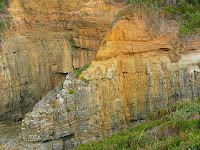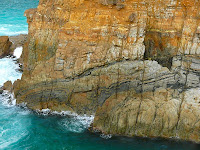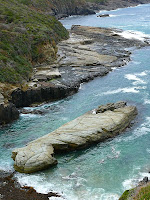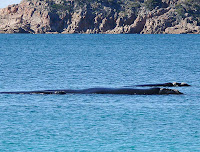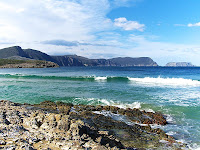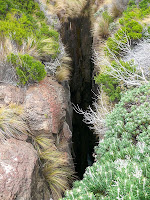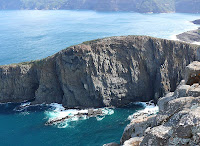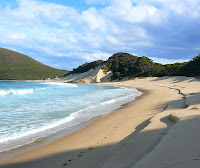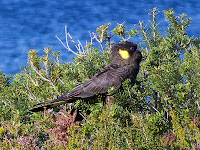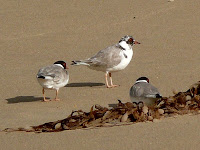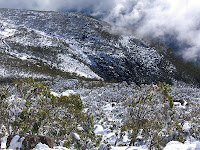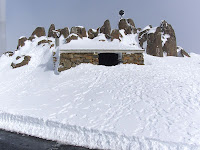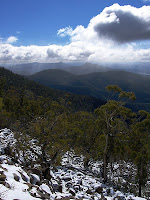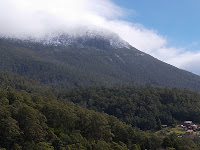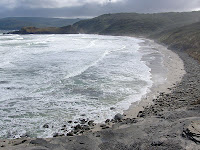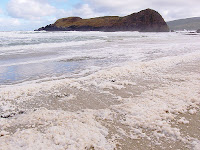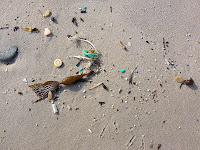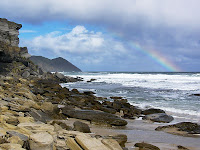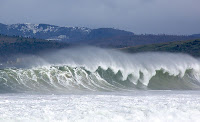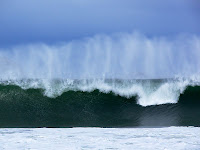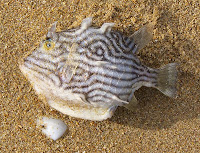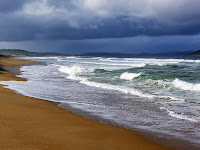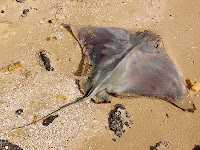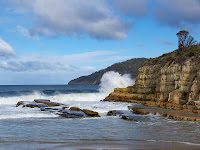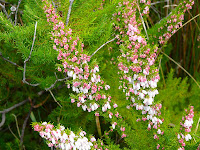
I first went to Cape Hauy (
Walk Description here.) in 1987, and I'm pretty sure it was the 16th July. I only remember that because I was taken (even surprised and alarmed!) with how warm and sunny Tasmania could be in the middle of winter when you were toiling up a steep hill. Anyway, the sun didn't disappoint yesterday, and came out warm and strong whenever I needed to walk up a hill. To get a clear understanding of the layout of the Cape and surrounds, it's worth stopping at the Pirates Bay Lookout, just along the old highway which turns off before the new highway drops steeply to Eaglehawk Neck. From here you can clearly see the Cape, Candlestick, Totem Pole and Lanterns, a view which you don't get once you are on the Cape.
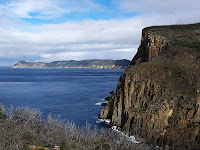 The Cape Hauy walk is very worthwhile, with the scenery and surrounds quite spectacular. The walk undulates a little, and the need for climbs and descents can surprise the unwary given the proximity to the sea. Fortescue Bay itself is a lovely place, obviously very well used - this is a favourite fishing and camping spot for many - but quite well maintained and managed. The drive in however has gradually become more and more a showcase for Tasmanian forestry operations, with vast swathes of forest demolished within clear sight of the road. The old track to Cape Pillar has been re-routed due to forestry operations across its old route. The National Park also shows the effects of fire escapes, both here and on the Forestier Peninsula. The track itself is quite liberally strewn with the debris from fallen trees, burnt a few years ago. If this is to become an iconic walk, I can see a bit of effort is going to be required to make the track more usable. However, over recent years, some useful lengths of planking have been placed across the plateau to mitigate the worst of the erosion we were causing, and reduce the dampness underfoot.
The Cape Hauy walk is very worthwhile, with the scenery and surrounds quite spectacular. The walk undulates a little, and the need for climbs and descents can surprise the unwary given the proximity to the sea. Fortescue Bay itself is a lovely place, obviously very well used - this is a favourite fishing and camping spot for many - but quite well maintained and managed. The drive in however has gradually become more and more a showcase for Tasmanian forestry operations, with vast swathes of forest demolished within clear sight of the road. The old track to Cape Pillar has been re-routed due to forestry operations across its old route. The National Park also shows the effects of fire escapes, both here and on the Forestier Peninsula. The track itself is quite liberally strewn with the debris from fallen trees, burnt a few years ago. If this is to become an iconic walk, I can see a bit of effort is going to be required to make the track more usable. However, over recent years, some useful lengths of planking have been placed across the plateau to mitigate the worst of the erosion we were causing, and reduce the dampness underfoot.
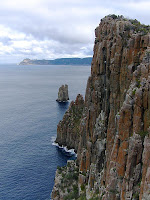 Once you descend onto the peninsula of Cape Hauy, the views to north and south open up quite dramatically. To the south, Cape Pillar makes a fine sight, with The Blade and Tasman Island visible. To the north, the coastline of the Tasman and Forestier Peninsulas, Cape Bernier, Maria Island and Freycinet are visible. On a clear day you may be able to see further than that. The track emerges at the end onto a small rock platform with a sheer 100m+ drop into the sea. Great care is required (especially if here with children), but this is the best spot for stopping and taking in the views and having lunch. Cape Hauy is home to the Candlestick and Totem Pole, both of great interest to climbers. They make spectacular viewing.
Once you descend onto the peninsula of Cape Hauy, the views to north and south open up quite dramatically. To the south, Cape Pillar makes a fine sight, with The Blade and Tasman Island visible. To the north, the coastline of the Tasman and Forestier Peninsulas, Cape Bernier, Maria Island and Freycinet are visible. On a clear day you may be able to see further than that. The track emerges at the end onto a small rock platform with a sheer 100m+ drop into the sea. Great care is required (especially if here with children), but this is the best spot for stopping and taking in the views and having lunch. Cape Hauy is home to the Candlestick and Totem Pole, both of great interest to climbers. They make spectacular viewing.
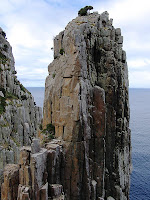 The Candlestick stands next to the end of the Cape clearly visible just next to the lunch spot, and behind it are The Lanterns. The Candlestick is a very tall and thin sea stack, separated from the Cape and the Lanterns by the sea. Lots of information here about climbing these things. As their guide says, the crux of the climb up the Candlestick is the SWIM! You can scramble down the less steep side of the Cape towards the sea, and actually you can get within a few metres of the sea if you keep going. This requires great care in places, and of course you have to climb back up the 100m of height. It does however afford better views of the Candlestick and Totem Pole, and these start only a short way down. My perambulations yesterday had to be curtailed because I took a sidetrip to the Tesselated Pavement on the drive in and left myself rather short of time.
The Candlestick stands next to the end of the Cape clearly visible just next to the lunch spot, and behind it are The Lanterns. The Candlestick is a very tall and thin sea stack, separated from the Cape and the Lanterns by the sea. Lots of information here about climbing these things. As their guide says, the crux of the climb up the Candlestick is the SWIM! You can scramble down the less steep side of the Cape towards the sea, and actually you can get within a few metres of the sea if you keep going. This requires great care in places, and of course you have to climb back up the 100m of height. It does however afford better views of the Candlestick and Totem Pole, and these start only a short way down. My perambulations yesterday had to be curtailed because I took a sidetrip to the Tesselated Pavement on the drive in and left myself rather short of time.
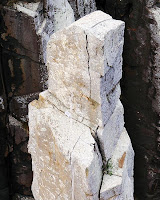 Next to the Candlestick stands the Totem Pole. The climbing guide says this about the Totem Pole: "It is over sixty metres tall, but only about four metres wide at the base. It sways in the wind and shudders with the crash of every wave." Go here for some more dramatic photos of the Totem Pole.
Next to the Candlestick stands the Totem Pole. The climbing guide says this about the Totem Pole: "It is over sixty metres tall, but only about four metres wide at the base. It sways in the wind and shudders with the crash of every wave." Go here for some more dramatic photos of the Totem Pole.
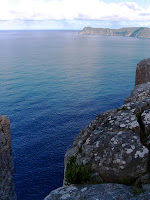 A final detour on the return is well worthwhile to the Monument Lookout. This stands on top of a vertical 150m drop to the sea, and requires great care, as the rocks are rounded and sloping, with good sized cracks between them. Views from here are to the rock stacks off Cape Hauy and Cape Pillar, and in fact very dramatically straight downwards to the surface of the sea. Great place to sit on a nice day.
A final detour on the return is well worthwhile to the Monument Lookout. This stands on top of a vertical 150m drop to the sea, and requires great care, as the rocks are rounded and sloping, with good sized cracks between them. Views from here are to the rock stacks off Cape Hauy and Cape Pillar, and in fact very dramatically straight downwards to the surface of the sea. Great place to sit on a nice day.
View Larger Map
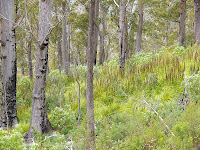 Yesterday I went for a walk on Mt Wellington for a while. It was supposed to be a warm day, but it remained overcast with a chilly breeze on the mountain slopes. I discovered part-way around that I seemed to be doing the "Organ Pipes Walk" which is one of the 60 Great Short Walks. There didn't seem to be very many people around. This walk sets out from The Springs, climbs beneath the Organ Pipes, then descends to Junction Cabin via Hunters Track. The last bit is the gentle climb back to The Springs along the Lenah Valley Track. This is a good walk on a day when you don't want to climb to the summit. The forest below the chalet along Hunters Track and through along part of the lenah Valley Track shows the effects of fire a few years ago. As I recall, this was a deliberately lit blaze that started behind Glenorchy and climbed the mountain, cutting quite a swathe through the nearly 40 years of regrowth since it was devastated by the 1967 fires. It wasn't as devastating as the earlier fire though, and the forest is recovering. The light yesterday wasn't very inspiring for photographs, but the walk was welcome exercise after a week at work.
Yesterday I went for a walk on Mt Wellington for a while. It was supposed to be a warm day, but it remained overcast with a chilly breeze on the mountain slopes. I discovered part-way around that I seemed to be doing the "Organ Pipes Walk" which is one of the 60 Great Short Walks. There didn't seem to be very many people around. This walk sets out from The Springs, climbs beneath the Organ Pipes, then descends to Junction Cabin via Hunters Track. The last bit is the gentle climb back to The Springs along the Lenah Valley Track. This is a good walk on a day when you don't want to climb to the summit. The forest below the chalet along Hunters Track and through along part of the lenah Valley Track shows the effects of fire a few years ago. As I recall, this was a deliberately lit blaze that started behind Glenorchy and climbed the mountain, cutting quite a swathe through the nearly 40 years of regrowth since it was devastated by the 1967 fires. It wasn't as devastating as the earlier fire though, and the forest is recovering. The light yesterday wasn't very inspiring for photographs, but the walk was welcome exercise after a week at work.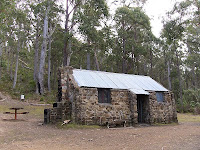 Junction Cabin is a cosy place on a wet day as long as someone has lit a fire. The area around here has been used for camping as well at times, and I have heard people say it was the first place they took their young children for an overnight walk. The grassy areas around the hut are a little slopy, but you could certainly put a tent up. The hut has a water tank and table/benches inside. There is often a supply of firewood left here by the rangers/council.
Junction Cabin is a cosy place on a wet day as long as someone has lit a fire. The area around here has been used for camping as well at times, and I have heard people say it was the first place they took their young children for an overnight walk. The grassy areas around the hut are a little slopy, but you could certainly put a tent up. The hut has a water tank and table/benches inside. There is often a supply of firewood left here by the rangers/council.

